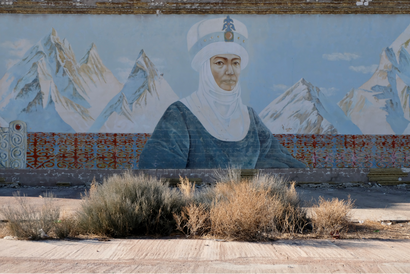The Eagle has Landed: Hunting with the Last Eagle Hunters in Kyrgyzstan

High above the southern shore of Issyk-Kul lake, in east Kyrgyzstan, we wait and watch for movement on the rocky hillside below. Movement means prey. And that means that the hunt is on for Sulukke, our Golden Eagle. For centuries, the nomadic people of Central Asia have used eagles to hunt for food and fur. On one a freezing morning in December, I went hunting with Nur-Sultan, Kyrgyzstan’s most famous eagle hunter.
The ancient tradition of hunting with Golden Eagles
The bond between eagle and man is strong. For thousands of years, the nomads who roamed the slopes of the steppe across Kyrgyzstan, Kazakhstan and Mongolia have tamed these giant birds, hunted alongside them, and then passed on that knowledge on to the next generation. Eagle and man, side by side. Hunting foxes, hares and even wolves to survive the long, cold winter months.
Hunting with eagles was once widespread across the region. Almost every young man would prove his manhood by capturing a baby eagle, train it, and then hunt with it by his side. But, the practice of hunting with eagles was almost wiped out during the Soviet era. The state forced many nomad tribes to live in newly built towns and cities. Ancient rituals, traditions and local languages, were strongly discouraged, sometimes even banned. Today, there are just 50 eagle hunters left in Kyrgyzstan, an art that mostly survives on tourism.

Human and animal, side-by-side
But, eagles are not pets. They’re hunting partners. An eagle hunter will steal an female eaglet from its nest when it just is 3 months old. Some men are killed when the eagle parent returns to its nest during the heist, and attacks them. The hunter will spend almost every waking moment of the next year by the eaglet’s side. Caring for her, feeding her by hand, talking and singing to her, as to build a special bond with his new hunting partner.
When the eagle is a year old, the hunter will fasten a fox fur to a rope and drag it behind him to train her. After a few months, the eagle is ready to hunt live animals. This is the moment of truth, the test of the killer instinct. If successful, the eagle will spend 20 years with its human, before being released back into the wild to live out the next 20-30 years of its life.
The hunt begins and finishes…
We start out on horseback. When the mountain path becomes too steep, we continue on foot. Hunting requires patience. We stop every 100 metres, and throw a rock into the scrub below in the hopes of disturbing a hare or fox. We scan the hillside below, watching for any movement. When a fox does eventually appear, Nur-Sultan removes the cap from Sulukke head so she can see. She immediately spreads her wings and soars it the valley…before coming to rest on a rock. The fox has already disappeared.
After four hours, we hike back down the hill. We were not successful today, but Sulukke still needs to eat. Nur-Sultan uses a live rabbit to show me how the hunt works. It’s brutal and raw. Sulukke swoops down onto the rabbit, sinks her powerful talons into its soft fur and tears it apart piece by piece. The hunt is over.

Comrade Kiev creates sustainable, ethical, design-led tours to the most incredible places on earth. Roads at the Roof of the World grants travellers a rare glimpse of lands largely untouched ideological undulations, and the people who call them home. Explore tour






